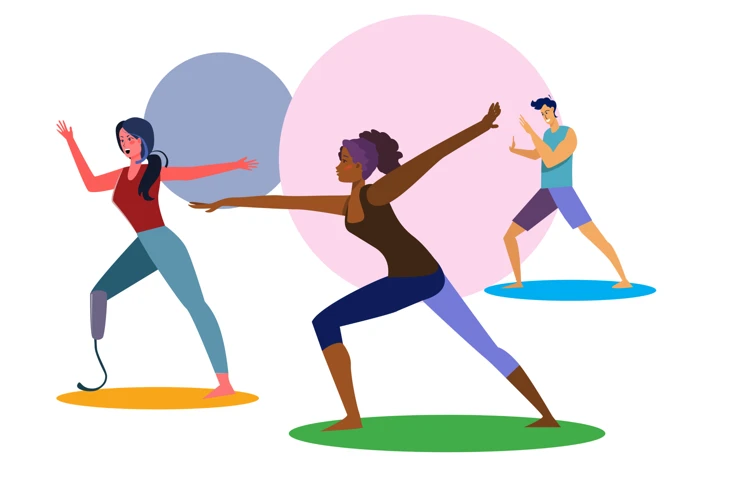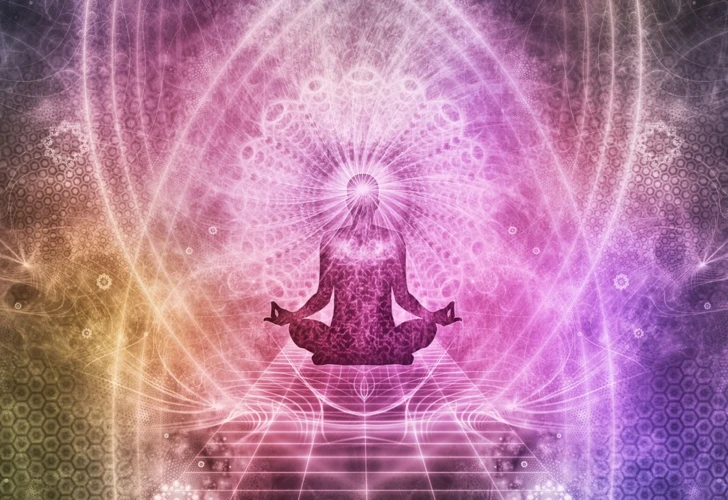In a world where we are constantly bombarded with distractions and stressors, finding ways to connect with our physical selves can feel like a daunting task. However, there is a powerful tool that can help us achieve this connection: mindful movement meditation. Through intentional movement and breath work, this practice allows us to focus our minds and connect deeply with our bodies. But what exactly is mindful movement meditation, and how can we cultivate a consistent practice? In this article, we will explore the benefits of this practice, provide a step-by-step guide to get started, and offer tips for cultivating a regular routine.
What is Mindful Movement Meditation?

Have you ever felt disconnected from your physical body? Do you struggle to quiet your mind during traditional meditation practices? Mindful movement meditation may be the solution you’ve been searching for. This practice combines movement with mindfulness to help you connect with your body and calm your mind. But what exactly is mindful movement meditation and how does it differ from other types of meditation? Let’s explore this practice together.
How is it Different from Other Types of Meditation?
Among the different types of meditation, mindful movement meditation stands out as a unique practice. Here are some ways it differs from other types of meditation:
| Type of Meditation | Distinguishing Characteristics |
|---|---|
| Zazen or Sitting Meditation | This traditional form of meditation involves assuming a stable and comfortable seated position and focusing on the breath or a particular object of concentration. Unlike mindful movement meditation, it is a static practice that does not involve bodily movement. |
| Transcendental Meditation | This type of meditation involves the use of a personalized mantra, or sound or phrase, repeated silently to oneself during the practice. Unlike mindful movement meditation, the focus is not on the movement of the body but rather on the repetitive sound or phrase. |
| Loving-Kindness Meditation | This practice involves generating feelings of love, kindness, and compassion towards oneself and others. Unlike mindful movement meditation, it does not involve physical movement, but rather focuses on cultivating positive mental and emotional states. |
| Vipassana or Insight Meditation | This type of meditation involves developing heightened awareness of the present moment, including thoughts, emotions, and bodily sensations. Unlike mindful movement meditation, the focus is not on physical movement but on the observation of one’s internal experiences. |
While other types of meditation may involve static poses, internal repetition, or mental focus, mindful movement meditation stands apart by incorporating physical movement as a means of connecting with the present moment and fostering mindfulness.
Why is it Effective for Connecting with the Physical Self?
Mindful movement meditation is effective for connecting with the physical self because it involves intentionally turning our focus inward and being fully present in the moment with our bodies. Here are some reasons why it has proven to be an effective practice for strengthening the mind-body connection:
- Boosts body awareness: By combining movement with mindfulness, we can develop a deeper understanding and appreciation of our bodies. We become more aware of the physical sensations and limitations of our bodies and learn to move with greater efficiency and ease.
- Reduces stress: Engaging the mind and body together in a practice of mindful movement can help to reduce stress and anxiety. By bringing our awareness to the present moment through movement, we shift our focus away from worries and stressors.
- Increases mind-body connection: When we engage in mindful movement, we are intentionally focusing our attention on both the physical sensations in our body and the present moment. By doing this, we create a strong connection between the two and gain a greater understanding of how our physical movements are impacted by our thought patterns and emotions.
- Improves physical health: The combination of movement and mindfulness has been shown to have numerous physical benefits, from improving balance and mobility to boosting cardiovascular health. Additionally, mindful movement can help to alleviate chronic pain and decrease inflammation in the body.
- Enhances self-awareness: Mindful movement can help us become more aware of our habitual movement patterns and postural habits, allowing us to make adjustments and develop healthier habits.
Mindful movement meditation is a powerful tool for cultivating a stronger mind-body connection, reducing stress, and improving physical, mental, and emotional well-being.
Benefits of Mindful Movement Meditation

As we continue exploring the practice of mindful movement meditation, it’s important to understand the numerous benefits it offers. This form of meditation goes beyond just calming the mind and offers a full-body experience. From physical improvements to emotional and spiritual growth, the benefits of mindful movement meditation can be transformative. Let’s take a closer look at what the practice can do for you.
Physical Benefits
Mindful movement meditation is a powerful technique that offers numerous physical benefits to practitioners. It involves deliberate movements coupled with breathing techniques that are designed to help you connect with your body and find inner peace. These physical benefits include but are not limited to:
| Improved Flexibility: | Regular practice of mindful movement meditation can help to improve your flexibility and range of motion, reducing your risk of injury and allowing you to perform everyday tasks with ease. |
| Increased Energy: | Mindful movement meditation can help to increase blood flow and oxygen supply to your muscles, reducing fatigue and increasing your overall energy levels. |
| Better Posture: | Practicing mindful movement meditation can help to improve your posture and reduce pain in your back, neck, and shoulders resulting from poor posture. |
| Reduced Inflammation: | Studies have shown that mindfulness meditation can help to reduce inflammation in the body, which is linked to several chronic diseases such as heart disease, Alzheimer’s, and depression. |
| Lower Blood Pressure: | Mindful movement meditation has been found to help lower blood pressure, which can reduce your risk of heart attack, stroke, and other cardiovascular diseases. |
| Improved Balance: | By practicing mindful movement meditation, you can improve your balance and coordination. This can help to reduce your risk of falls and other injuries, especially as you age. |
In addition to these physical benefits, practicing mindful movement meditation can also lead to mental, emotional, and spiritual benefits.
Mental and Emotional Benefits
Mindful Movement Meditation not only has physical benefits but also has mental and emotional benefits. Here are some of the benefits of Mindful Movement Meditation for the mind and emotions:
- Reduces Stress and Anxiety: Mindful Movement Meditation allows the mind to focus on movements and the breath, which reduces the production of the stress hormone cortisol. This decrease in cortisol levels leads to a reduction in stress and anxiety.
- Increases Positive Emotions: Mindful Movement Meditation helps in reducing negative emotions like anxiety, stress, and depression. It increases positive emotions like joy, love, and gratitude. Thus, it promotes emotional well-being by helping individuals to attain emotional stability.
- Improves Cognitive Functions: Mindful Movement Meditation helps in improving cognitive functions like focus, attention, and memory, leading to better productivity, creativity, and decision-making abilities.
- Develops Emotional Resilience: Mindful Movement Meditation cultivates emotional resilience, which is the ability to bounce back from difficult situations effectively. The practice helps individuals to be more aware of their emotional state, which in turn helps them to cope better with stressful situations.
- Enhances Self-Awareness: Mindful Movement Meditation promotes self-awareness by encouraging individuals to observe their thoughts, emotions, and physical sensations. The practice enables individuals to understand their emotions and thoughts better, leading to greater self-awareness and a sense of self-control.
Mindful Movement Meditation has various mental and emotional benefits, making it a powerful practice that can lead to holistic well-being. It is an effective tool for developing resilience and emotional stability while reducing negative emotions like stress, anxiety, and depression. Practice of Mindful Movement Meditation can help individuals lead a more fulfilling life.
Spiritual Benefits
Mindful movement meditation doesn’t just offer physical and mental benefits, it has also been shown to have significant spiritual benefits. Through this practice, individuals may experience a deeper connection to their spiritual selves and a greater sense of purpose and meaning in their lives.
Here are some spiritual benefits of mindful movement meditation:
| Benefit | Description |
|---|---|
| Increased Awareness | Mindful movement meditation can help you become more aware of your surroundings and the people around you. This mindfulness can help you cultivate a greater sense of connectedness and empathy towards others. |
| Heightened Intuition | Through a regular mindfulness practice, some individuals have reported an increase in their intuition or gut feelings. This can help you make better decisions in your personal and professional life. |
| Greater Compassion | By connecting with your physical self, you can become more in tune with your emotions and those of others. This can lead to a greater sense of compassion and kindness towards yourself and others. |
| Deepening of Spiritual Practice | Mindful movement meditation can be a powerful tool for deepening spiritual practice. By getting in touch with your physical body, you may also experience a deeper sense of connection with the divine, however you may define it. |
Regular practice of mindful movement meditation can lead to a greater sense of purpose and fulfillment in life, as well as a deeper sense of connectedness to the world around you.
How to Practice Mindful Movement Meditation

Now that you understand the benefits of mindful movement meditation, you may want to start incorporating this practice into your daily routine. But how can you begin? The answer is to start small and build gradually over time. With consistency and patience, you can cultivate a deeper connection with your physical self through mindful movement meditation. In this section, we’ll provide you with a step-by-step guide on how to practice this type of meditation. So, find a quiet and comfortable space, and let’s get started.
Preparing for Your Practice
Before beginning your mindful movement meditation practice, it is important to prepare both mentally and physically. This will help you to get the most out of your practice and create a peaceful and focused mindset. Here are some steps you can take to prepare for your practice:
| Step | Description |
| 1 | Create a Comfortable Space – Find a quiet, comfortable space where you can practice without interruption for the duration of your session. If necessary, dim the lighting, close any doors or windows, and make sure the temperature is comfortable. |
| 2 | Wear Comfortable Clothing – It is important to wear loose, comfortable clothing that allows you to move freely. Avoid clothing that is too tight or restrictive, as this may interfere with your ability to relax and focus. |
| 3 | Choose Your Music – Depending on your personal preference, you may wish to listen to calming and relaxing music while you practice. Choose music that is soft and soothing, without any sudden or jarring sounds that may startle you out of your meditation. |
| 4 | Clear Your Mind – Take a few minutes to clear your mind of any distractions or stressors. Close your eyes, take a deep breath in through your nose, and exhale slowly through your mouth. Repeat this several times until you feel relaxed and calm. |
| 5 | Set Your Intention – Before beginning your practice, take a moment to set your intention for this meditation. Ask yourself what you hope to gain from this experience, and visualize yourself achieving these goals. |
By following these steps, you can prepare yourself for a successful mindful movement meditation practice. Remember that preparation is key to achieving a deep connection with your physical self and experiencing the full benefits of this form of meditation.
Step-by-Step Guide to Mindful Movement Meditation
Step-by-Step Guide to Mindful Movement Meditation
1. Find a quiet and comfortable place to practice, preferably with enough space to move around freely.
2. Begin by standing with your feet hip-width apart and grounding yourself by feeling the weight of your body evenly distributed between both feet.
3. Bring your attention to your breath, and take a deep inhale through your nose, filling your belly with air. Exhale slowly through your mouth, releasing any tension in your body. Repeat this a few times until you feel relaxed and centered.
4. Start moving slowly and mindfully. Any movement can be used, such as stretching, dancing, or yoga poses. The key is to focus on each movement, paying attention to the sensations in your body.
5. As you move, continue to focus on your breath, inhaling and exhaling deeply.
6. Allow yourself to be present in the moment, releasing any thoughts of the past or future.
7. If you find your mind wandering, gently bring your attention back to your breath and the physical sensations in your body.
8. Keep moving mindfully for at least 10-15 minutes, gradually slowing down as you approach the end of your practice.
9. End your practice with a few minutes of stillness, standing or sitting with your eyes closed and taking a few deep breaths.
10. Take a moment to reflect on the experience and notice any changes in how you are feeling.
Remember, the goal of mindful movement meditation is not to achieve a specific physical outcome, but rather to connect with your body and cultivate mindfulness in your daily life.
Tips for Cultivating Mindful Movement Meditation
As with any form of meditation, mastering the art of mindful movement takes practice, patience and consistency. Here are some tips that will help you cultivate a successful and beneficial mindfulness movement meditation practice to connect with your physical self fully. By applying these techniques, you may find that mindfulness movement meditation becomes a natural and meaningful component of your daily life.
Consistency is Key
Maintaining consistency is crucial when it comes to practicing mindful movement meditation. It is essential to commit to a regular practice, which can vary in duration but should occur on a routine basis.
One effective approach for building consistency is to create a set schedule that works for your situation. Whether it’s a few minutes in the morning or a longer session at night, find a time that fits your lifestyle and commit to sticking to it.
| PROS | CONS |
| Helps establish a routine | May be difficult to commit to a set schedule initially |
| Prevents procrastination or avoidance of practice | May limit flexibility in scheduling |
| Increases the likelihood of progress and improvement | May require adjusting other activities or responsibilities |
By consistently practicing mindful movement meditation, we can cultivate a deeper connection with our physical selves and reawaken sensations that may have become dormant over time. Consistency helps us to develop new habits and thought patterns, allowing us to reap the full benefits of the practice for our body, mind, and spirit.
Ultimately, incorporating mindful movement meditation into our daily routine can lead to a more balanced, grounded, and present way of being. So, commit to consistency and notice the positive changes that will inevitably follow.
Avoid Comparing Yourself to Others
When practicing mindful movement meditation, it is important to avoid comparing yourself to others. This can be a challenging task, as we often instinctively compare ourselves to those around us. However, this type of comparison can be more harmful than helpful, as it can lead to feelings of inadequacy, discouragement, or even self-criticism. Instead, try to focus on your own practice and progress, and trust that you are on your own unique journey.
One way to avoid comparing yourself to others is to cultivate a sense of self-awareness and self-compassion. This involves acknowledging your thoughts and feelings without judgment or criticism, and recognizing that everyone has their own strengths and weaknesses. To do this, you may want to set aside some time for introspection or self-reflection, such as journaling or meditation.
Another way to avoid comparison is to focus on your own personal goals and intentions. This can help you stay motivated and grounded in your own practice, rather than getting caught up in external factors such as competition or social comparison. To do this, you may want to write down your goals, intentions, or affirmations and read them regularly as a reminder.
It can also be helpful to surround yourself with supportive and like-minded individuals who share your interest in mindful movement meditation. This can help you stay motivated and inspired, and provide a sense of community and connection.
Remember that everyone’s journey is unique, and that progress is not always linear. It is important to celebrate your own accomplishments and growth, no matter how small they may seem. Comparing yourself to others only serves to distract you from your own path, and can prevent you from fully embracing the present moment. Stay focused on yourself and your own practice, and trust that you are exactly where you need to be.
| Ways to avoid comparing yourself to others: |
|---|
| Cultivate self-awareness and self-compassion |
| Focus on personal goals and intentions |
| Surround yourself with supportive individuals who share your interest |
| Celebrate your own growth and accomplishments |
Be Patient with Your Progress
It’s important to remember that progress in mindful movement meditation takes time and practice. Everyone’s journey is unique, and it’s important to be patient with yourself as you navigate through the process. Here are some tips to help you cultivate patience along the way:
| Tip 1: | Set realistic expectations for yourself. Remember that progress takes time, and it’s okay if you don’t see immediate results. |
| Tip 2: | Focus on the present moment rather than the end goal. Trust the process and enjoy the journey. |
| Tip 3: | Don’t compare your progress to others. Everyone moves at their own pace, and comparison can lead to discouragement and frustration. |
| Tip 4: | Practice self-compassion. Be kind to yourself and acknowledge that setbacks are a natural part of the process. |
By being patient and following these tips, you can cultivate a sense of calm and presence both on and off the mat. Remember that mindful movement meditation is a lifelong journey, and every step you take is a step towards greater connection with your physical self.
Conclusion
In conclusion, engaging in mindful movement meditation can be a powerful tool for connecting with one’s physical self and achieving a state of inner peace and balance. By incorporating movement, breath, and mindfulness, this practice can provide numerous benefits for our physical, mental, and spiritual well-being.
Through the practice of mindful movement meditation, we can learn to cultivate greater awareness of our bodies, our thoughts, and our emotions. This heightened sense of self-awareness can help us to be more present in our daily lives and better equipped to deal with stress, anxiety, and other challenges that can arise.
It is important to remember that like any new skill, mindful movement meditation requires practice and patience. It may take time to find the right techniques and approaches that work best for you, but with consistency and dedication, you can reap the benefits of this powerful practice.
So, if you’re ready to connect with your physical self in a deeper and more meaningful way, consider adding mindful movement meditation to your routine. Start small, be patient with yourself, and let the practice guide you towards greater health, happiness, and balance.
Frequently Asked Questions
Can anyone practice mindful movement meditation?
Yes, anyone can practice mindful movement meditation regardless of age or fitness level.
What are some examples of mindful movement meditation practices?
Some examples include yoga, tai chi, qigong, dance meditation, and walking meditation.
Do I need special equipment or clothing to practice mindful movement meditation?
No, you don’t need any special equipment or clothing. Wear comfortable clothing and practice in a clean and safe space, preferably with natural light or good lighting.
Do I need to be flexible to practice mindful movement meditation?
No, you don’t need to be flexible. The practice is more about connecting with your body and breath, rather than achieving a certain level of physical flexibility or fitness.
How long should I practice mindful movement meditation?
You can start with as little as 5-10 minutes per day and gradually increase as you feel comfortable. Aim for at least 20-30 minutes per session for optimal benefits.
Can I combine mindful movement meditation with other types of meditation?
Yes, you can combine mindful movement meditation with other types of meditation, such as breathing meditation or visualization meditation.
Can mindful movement meditation help me relieve stress and anxiety?
Yes, mindful movement meditation has been shown to be effective in relieving stress and anxiety, as well as improving overall mental and emotional well-being.
Is it safe to practice mindful movement meditation if I have a physical injury or condition?
Consult with your healthcare provider before starting any new exercise regimen, including mindful movement meditation. Modify the practice as needed based on your individual capabilities and limitations.
Can practicing mindful movement meditation improve my posture?
Yes, regular practice of mindful movement meditation can help improve your posture by increasing body awareness and strengthening core muscles that support proper alignment.
Can I practice mindful movement meditation with a group?
Yes, practicing with a group can be a supportive and motivating way to practice mindful movement meditation. Look for local classes or workshops in your area, or consider starting your own group practice.








